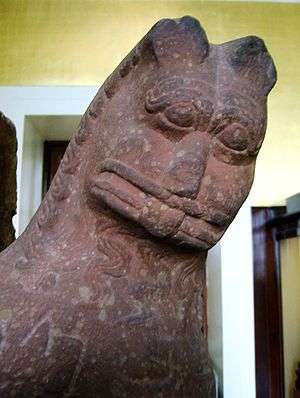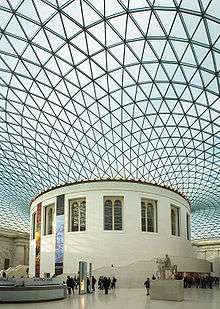Mathura lion capital
|
The Mathura lion capital (British Museum) | |
| Material | Red Sandstone |
|---|---|
| Size | 16.75 inches tip to tip |
| Created | 1st century CE |
| Discovered | Mathura in Central India |
| Present location | British Museum, London |
The Mathura lion capital is an Indo-Scythian sandstone capital from Mathura in Central India, dated to the 1st century CE.
The capital was excavated by Bhagwan Lal Indraji in 1869.[1] It is covered with Prakrit inscriptions in the kharoshthi script of northwestern India.[2] The capital was made on the occasion of the funeral of "the illustrious king Muki and his horse" (Muki has been conjectured to be Maues).
The capital describes, among other donations, the gift of a stupa with a relic of the Buddha, by Queen Aiyasi Kamuia, the "chief queen of the Indo-Scythian ruler of Mathura, strap Rajuvula", mentioned as the "daughter of Kharaosta Kamuio" (See: Mathura Lion Capital inscriptions below). The lion capital also mentions the genealogy of several Indo-Scythian satraps of Mathura. It mentions Sodasa, son of Rajuvula, who succeeded him and also made Mathura his capital.
The capital also displays at its center a Buddhist triratana symbol, further confirming the involvement of Indo-Scythian rulers with Buddhism.
The inscription indicates support of the Sarvastivadin, against the Mahasamghikas.[3]
It is on display at the British Museum in the Joseph E. Hotung Gallery.
List of inscriptions

Here is the list of the inscriptions in simplified Gandhari script:[4]
- A1 mahaksha[tra]vasa rajulasa
- A2 agra-maheshi ayasia
- "Chief Queen Ayasia,"
- A3 kamuia dhida
- "The kamuia daughter of"
- A4 kharaostasa yuvarana
- "The heir-apparent Kharahostes,"
- A5 mada nada-diakasa [taye]
- A6 sadha matra abuhola[e]
- A7 pitramahi pishpasia bhra
- A8 tra hayuarana sadha hana dhi[tra]
- A9 a[te]urena horaka-pa
- A10 rivarena isha pradhravi-prade
- A11 she nisime sharira pradithavido
- "Has offered relics of"
- A12 bhakhavado shakamunisa budhasa
- A13 muki-[shiri]-raya sashpa [a]bhusavi[ta]
- A14 thuva ca sagharama ca cadu
- A15 dishasa saghasa sarva
- A16 stivadana parigrahe

- E1 kharaosto yuvaraya
- "The heir-apparent Kharahostes,"
- E’ kamuio
- "A kamuia"
- E2 khalamasa kumara
- E3 maja kanitha
- E4 saman[u] moda
- E’’ kha karita
- B1/B2 mahakshatravasa va[ra]julasa putra
- "The son of the Great Satrap Rajuvula:"
- C1 kalui a
- C2 varajo
- C3 sudase kshatrave
- "The Satrap Sodasa"
- D1 nauludo
- M1 kshatrave sudise
- M2 imo padhravi
- M3 pradesho
- I1 veyaudirna kadhavaro busapa
- I2 ro kadha
- I3 varo
- I4 vi ya u
- J1 rvaraparena palichina
- J2 nisimo karita niyadido
- H'dhamadana
- H guhavihare
- KL1 ayariasa
- KL2 budhadevasa
- "The divine Buddha"
- KL3 udaena ayimi[ta]
- F1 budhilasa nakharaasa
- F2 bhikhusa sarvastivadasa
- "Sarvastivada monk"
- G1/G2 mahakshat[r]avasa kusul[u]asa patikasa mevaki[sa] miyikasa kshat[r]avasa puyae
- "The satrap Miyika honours the great satrap Kusulaka Patika"
- J3 sarvastivadana parigrahe
- N1 ayariasa budhilasa nakharakhasa bhikhu
- N2 sa sarvastivadasa pagra
- N3 na mahasaghiana pra
- N4 ma navidave khalulasa
- O1/O2 sarvabudhana puya dhamasa puya saghasa puya
- P1/P2 sarvasa sakhasta nasa puyae
- "In reverence of all the dead Sakas"
- Q1 khardaasa
- "Kharda"
- Q2 kshatravasa
- "the Satrap"
- R1 takshilasa
- "Taxila"
- R2 kroninasa
- J'1 khalasamu
- J'2 so
Interpretation
Sten Konow, who compiled a definitive listing of Indian Buddhist inscriptions said: "If we bear in mind that mb becomes m i.e mm in the dialect of Kharoshthi dhammapada, and that u is used for the common o in Sudasa in the Lion Capital Inscriptions, the Kamuia of the Lion Capital can very well represent a Sanskrit Kambojika ... I shall only add that if Kharoshtha and his father Arta were Kambojas, the same may have been the case with Moga, and we understand why the Kambojas are sometimes mentioned with the Sakas and Yavanas".[5] Many of Konow's readings, his sequence of sentences and some of the interpretation, particularly the connection with king Maues, need to be changed in the light of a new reading of H. Falk.[6]
References
- ↑ Jason Neelis (19 November 2010). Early Buddhist Transmission and Trade Networks: Mobility and Exchange Within and Beyond the Northwestern Borderlands of South Asia. BRILL. p. 122. ISBN 90-04-18159-8.
- ↑ Red Sanstone Pillar Capital, British Museum, accessed August 2010
- ↑ Rosenfield, "The dynastic art of the Kushans", p.134
- ↑ List of the inscriptions on the Mathura lion capital
- ↑ Sten Konow, Corpus Inscriptionum Indicarum, Vol II, Part I, p xxxvi,p 36
- ↑ Harry Falk, "Ten thoughts on the Mathura Lion capital reliquary". Bhandare, Shailendra & Sanjay Garg (eds.), "Felicitas - Essays in Numismatics, Epigraphy and History in Honour of Joe Cribb". Mumbai, pp. 121-141

